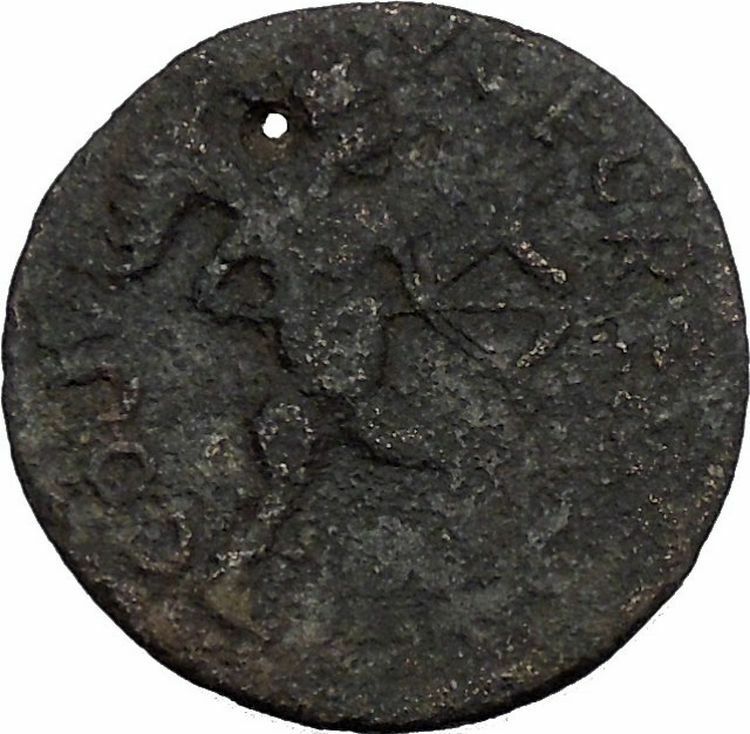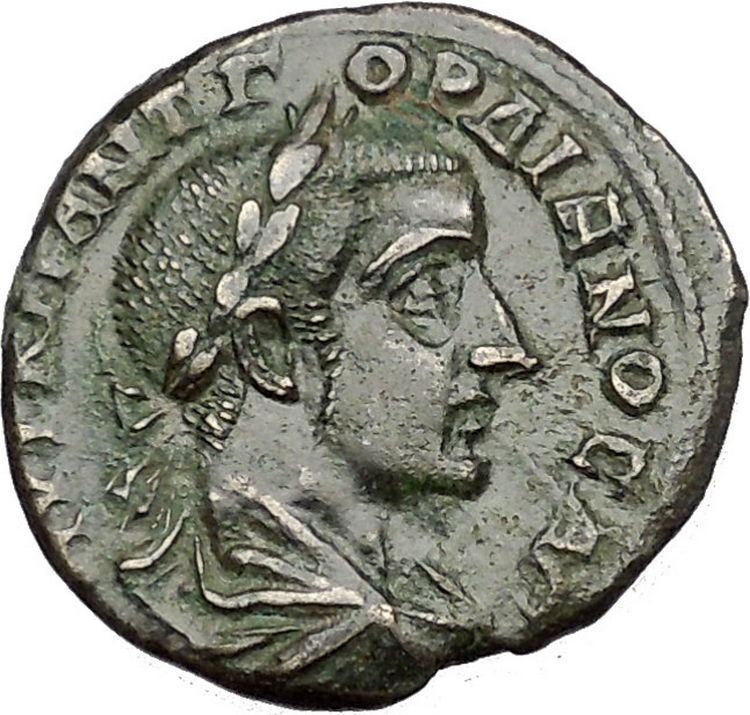|
Julia Domna
–
Roman Empress
Wife of
Emperor
Septimius Severus
193-211 A.D. –
Bronze 27mm (10.29 grams) of
Thessalonica in
Macedonia
Draped bust left.
ΘЄCCAΛONIKЄΩN,
Nike (Victory)
advancing left, holding wreath and palm branch.
You are bidding on the exact item pictured,
provided with a Certificate of Authenticity and Lifetime Guarantee of
Authenticity.

In
Greek mythology
,
Nike
was a
goddess
who personified
victory
, also known as the Winged Goddess of
Victory. The Roman equivalent was
Victoria
. Depending upon the time of various
myths, she was described as the daughter of
Pallas
(Titan) and
Styx (Water) and the sister of
Kratos
(Strength),
Bia
(Force), and
Zelus
(Zeal). Nike and her siblings were close
companions of Zeus
, the dominant deity of the
Greek pantheon
. According to classical (later)
myth, Styx brought them to Zeus when the god was assembling allies for the
Titan War
against the older deities. Nike
assumed the role of the divine
charioteer
, a role in which she often is
portrayed in Classical Greek art. Nike flew around battlefields rewarding the
victors with glory and fame.
Nike is seen with wings in most statues and paintings. Most other winged
deities in the Greek pantheon had shed their wings by Classical times. Nike is
the goddess of strength, speed, and victory. Nike was a very close acquaintance
of Athena
, and is thought to have stood in
Athena’s outstretched hand in the statue of Athena located in the Parthenon.
Nike is one of the most commonly portrayed figures on Greek coins.
Names stemming from Nike include amongst others:
Nicholas
, Nicola, Nick, Nikolai, Nils, Klaas,
Nicole, Ike, Niki, Nikita, Nika, Niketas, and Nico.
The city
Thessalonica in
Macedonia was founded around
315 BC
by the
King Cassander of Macedon
, on or near the site
of the ancient town of
Therma
and twenty-six other local villages. He
named it after his wife
Thessalonike
, a half-sister of
Alexander the Great
. She gained her name
(“victory of Thessalians”: Gk
nikē
“victory”) from her father,
Philip II
, to commemorate her birth on the day
of his gaining a victory over the
Phocians
, who were defeated with the help of
Thessalian
horsemen, the best in Greece at that
time. Thessaloniki developed rapidly and as early as the
2nd century BC
the first walls were built,
forming a large square. It was an autonomous part of the Kingdom of
Macedon
, with its own parliament where the King
was represented and could interfere in the city’s domestic affairs.
Roman
era
After the fall of the kingdom of Macedon in
168 BC
, Thessalonica became a city of the
Roman Republic
. It grew to be an important
trade-hub located on the
Via Egnatia
, the
Roman road
connecting
Byzantium
(later
Constantinople
), with
Dyrrhachium
(now
Durrës
in
Albania
), and facilitating trade between Europe
and Asia. The city became the capital of one of the four Roman districts of
Macedonia; it kept its privileges but was ruled by a
praetor
and had a Roman garrison, while for a
short time in the
1st century BC
, all the Greek provinces came
under Thessalonica (the Latin form of the name). Due to the city’s key
commercial importance, a spacious harbour was built by the Romans, the famous
Burrowed Harbour (Σκαπτός Λιμήν) that accommodated the town’s trade up to
the eighteenth century; later, with the help of silt deposits from the river
Axios
, it was reclaimed as land and the port
built beyond it. Remnants of the old harbour’s docks can be found in the present
day under Odos Frangon Street, near the Catholic Church.
Thessaloniki’s
acropolis
, located in the northern hills, was
built in 55 BC
after
Thracian
raids in the city’s outskirts, for
security reasons.
The city had a
Jewish
colony, established during the
first century
, and was to be an early centre of
Christianity
. On his second missionary journey,
Paul
of Tarsus
, born a Hellenized Israelite,
preached in the city’s synagogue, the chief synagogue of the Jews in that part
of Thessaloniki, and laid the foundations of a church. Other Jews opposed to
Paul drove him from the city, and he fled to
Veroia
. Paul wrote two of his
epistles
to the Christian community at
Thessalonica, the
First Epistle to the Thessalonians
and the
Second Epistle to the Thessalonians
.
Thessaloníki acquired a patron saint,
St. Demetrius
, in 306. He is credited with a
number of miracles that saved the city, and was the Roman
Proconsul
of Greece under the anti-Christian
emperor Maximian
, later martyred at a Roman prison
where today lies the
Church of St. Demetrius
, first built by the
Roman sub-prefect of
Illyricum
Leontios in 463. Other important
remains from this period include the
Arch and Tomb of Galerius
, located near the
centre of the modern city.
Julia
Domna (unknown date–217)
was a member of the
Severan dynasty
of the
 Roman Roman
Empire. Empress and wife of
Roman
Emperor
Lucius
Septimius Severus
and mother of Emperors
Geta
and Caracalla
, Julia was among the most important women ever to exercise power
behind the throne in the Roman Empire.
//
Family
background
Julia was of Syrian origin from the ancient city of
Emesa. Her
ancestors were Kings Priest of the famous temple of
Baal. The family
lost its kingdom to Rome but continued domination of the temple of Baal. The
family had an enormous wealth and was promoted to Roman senatorial aristocracy.
She was the youngest daughter of high-priest Gaius
Julius Bassianus
and her eldest sister was
Julia
Maesa
.
Reign
In the late 180s, Julia married future Emperor
Septimius Severus
who himself was in part of
Punic
background. The marriage proved to be a happy one and Severus
cherished his wife and her political opinions, since she was very well read and
keen on philosophy. Together, they had two sons, Lucius Septimius Bassianus (Caracalla)
in 186 and
Publius Septimius Geta
in 189.
Civil
War
When Severus became emperor in 193 he had a civil war waiting
for him, against rivals such as
Pescennius Niger
and
Clodius Albinus
. Julia accompanied him in his campaigns in the East, an
uncommon event in a time when women were expected to wait in Rome for their
husbands. Nevertheless, she remained with the emperor and among the several
proofs of affection and favour are the minting of coins with her portrait and
the title mater castrorum (mother of the camp).
Julia now had complete power and ruled behind the Roman
Empire. Many early Romans disliked the fact of her ruling over the throne when
Septimius Severus was at war.
Controversy
and transition of power
As empress, Julia was often involved in intrigues and had
plenty of political enemies who accused her of treason and adultery. None of
these accusations were proven, Severus continued to favour his wife and insisted
on her company in the campaign against the
Britons
that started in 208. When Severus died, in 211 in
York, Julia became
the mediator between their two sons.
Caracalla
and
Geta
who were to rule as joint emperors, according to their father’s wishes
expressed on his will. But the two young men were never fond of each other and
quarrelled frequently. Geta was murdered by Caracalla’s soldiers in the same
year.
Caracalla was now sole emperor, but his relations with his
mother were difficult, as attested by several sources, probably due to his
involvement in Geta’s murder. Nevertheless, Julia accompanied Caracalla in his
campaign against the
Parthian empire
in 217. During this trip, Caracalla was assassinated and
succeeded (briefly) by
Macrinus
.
On hearing about the rebellion, Julia chose to commit suicide. Her body was
brought to Rome and placed in the Sepulcrum C. et L. Caesaris (perhaps a
separate chamber in the
Mausoleum of Augustus
). Later, however, both her bones and those of Geta
were transferred by her sister
Julia
Maesa
to the
Mausoleum of Hadrian
.
She was later deified.
|





 Roman
Roman 


